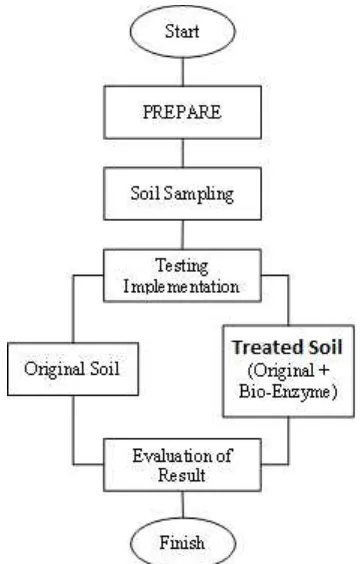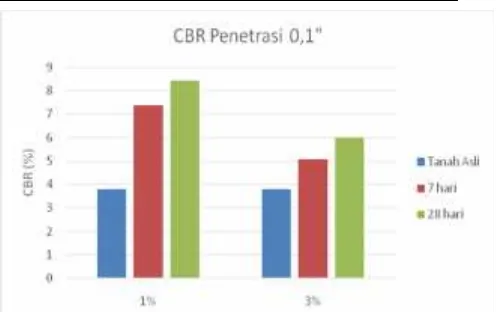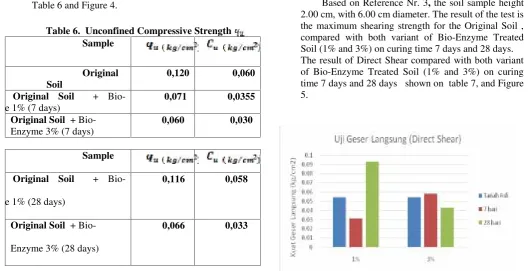Proceeding Forum in Research, Science, and Technology (FIRST) 2016
T
REATMENT OF
S
OIL
B
EARING
C
APACITY
U
SING
B
IO
-E
NZYME FOR THE
F
UTURE
Adi Prawito
1), Tony Hartono Bagio
2), Sri Wiwoho Mudjanarko
3), Makno Basoeki
4), Nandar Astowo
5) 1)Fakultas Teknik, Universitas Narotama, Surabaya, Indonesia E-mail: [email protected]
2)Fakultas Teknik, Universitas Narotama, Surabaya, Indonesia
E-mail: [email protected] 3)
Fakultas Teknik, Universitas Narotama, Surabaya, Indonesia E-mail: [email protected]
4)Founder of Biocon, Surabaya, Indonesia
E-mail: [email protected] 5)
Fakultas Teknik, Universitas Narotama, Surabaya, Indonesia E-mail: [email protected]
Abstract.There are many method of Soil Improvement to increase the soil bearing capacity to support the building which is exist on those soil. The recent method is Bio-Enzyme Treated Soil with bio-organic material based. The sampling soil used is original soil and bio-enzyme treated soil, with variation of concentration between 1% up to 3% and curing time 7 days and 28 days. The Laboratory test consist of California Bearing Ratio Test, Unconfined Compression Strength Test, and Direct Shear Test. The research of Laboratory Test was founded that soil sample has moisture content = 73.45%, specific gravity = 2.4 gr/cm3, Liquid Limit = 88.04 % and Plasticity Index is 51.50. The original soil sample is wet clay category. Refer to the physical behavior test for bio-enzyme treated soil, was founded that PI value will decrease, CBR shown increase compared to the original soil. Significantly increasing has been occurred on the original soil which is treated with Bio-Enzyme 1% on CBR value for0,1”penetration reached 8.43%, for 0.2”penetration reached 6.47% on curing time 28 days, compared with Bio-Enzyme Treated Soil 3% which is only reached CBR 6% on 0.1”penetration , and 4,84% on 0.2” penetration. From the unconfined compressive test result shown a decreasing of unconfined compressive test for the original soil. The Direct Shear Test for Bio-Enzyme Treated Soil shown increase compared with original soil. Meanwhile, with the increase of CBR means the Bio-Enzyme Treated Soil has been increased too.
Key Word : soil, original soil, bearing capacity, bio enzym
I. INTRODUCTION
Back Ground
Soil is the most important part support and interface to the sub structures. On every structural construction founded various problems especially on the mechanical properties of soil which is related to the bearing capacity. Every inches of the soil have its differential mechanical properties, event slightly differential. There is important thing to find out the method to treat the comprehensive soil mechanical properties related to the bearing capacity to support the foundation system.
As a reference of this study is ground with a low bearing capacity soil, such as peat, soil fishpond, clay and others are scattered throughout the region Indonesia especially in the Lingkar Timur, Sidoarjo.
Considering efficiency performance aspects and economical aspects, soil improvement with bio-enzyme is a new thing that is the basic material is Bio-organic, so it does not require a mixture of chemicals, known as Limestone, Cement, using calcium as basic materials.
GOAL
To determine the bearing capacity of soil before treatment Bio-Enzyme and after Treatment with Bio-Enzyme.
II. METHODOLOGY
Liquid limit (LL) of original soil, compared with the Treated Soil with Bio-Enzyme. Both types of soil test are in determining the soil bearing capacity comparison between the clay original (un-treated) with Bio-Enzyme Treated Clay/Soil. Bio-Enzyme usage was designated to increase the soil strength or soil bearing capacity. Detail of Soil samples shown in Table 1:
Table 1. Details of Soil Samples
No. Soil Samples
Curing Time 7 days and 28 days
CBR UCS DS
1 Original Soil (OS) 1 1 1
2 OS + 1% Bio-Enzyme 2 2 2
Where:
OS = Original Soil B.E = Bio-Enzyme
UCS = Unconfined Compression Strength test DS = Direct Shear tests
CBR = California Bearing Ratio tests
FLOW CHART
The research procedure shown on the following figure 1,
Figure 1. Research Procedure Flow Chart Mixing Bio-Enzyme
After taking samples of the original soil finalized, then discharge the original soil from the tube and dilute the Bio-Enzyme 1% amount 6 samples and Bio-Bio-Enzyme Treated Soil 3% for 6 samples. 1% and 3% were counted from the original soil weight. After Bio-Enzyme Treated Soil samples finalized, those soil refilled to the tube to control the soil physical structures remain same with the original soil, for 7 days and 28 days. After that the samples discharge from the tube for laboratory test of soil mechanical properties.
Method of Testing
Laboratory Tests for the Original Soil and Bio-Enzyme Treated Soil, consist of:
• Atterberg Limit Tests, based on the reference [5], consist of Plastic Limit (PL), Liquid Limit (LL) and Plasticity Index (PI).
• Liquid Limit.
The goal of this test is to determine the water content of a soil on limit between plastic condition and liquid
condition. The Method of Work is referred to ASTM D 4318-00.
• Plastic Limit.
The goal of this test is to determine the water content of a soil on the limit between plastic condition and semi dense condition. The Method of Work is referred to ASTM D 4318, in order to determine the tested soil samples water content. The Calculation of Plastic Limit is the average water contents of the three soil samples Plastic Index (PI).
PI = LL–PL
• California Bearing Ratio (CBR) Testing.
CBR Test is dedicated to determine bearing capacity of tested soil samples which will be used for the road construction. The Method of Work is referred to ASTM D1883.
• Unconfined Compressive Strength (UCS) Test
Unconfined Compressive Strength (UCS) Test is dedicated to determine shearing strength of tested cohesive soil samples which will be used for the road construction. The Method of Work is referred to ASTM D2166-06.
• Direct Shear ( DS ) Test
Direct Shear (DS) Test is dedicated to determine shearing resistance strength on the normal stress. The goal is to determine soil shearing strength. The function of the tested Direct Shear Result is dedicated for the Soil Slope Stability for Geo-Technical Analysis. The Method of Work is referred to ASTM D-3080-04.
III. RESULTS AND DISCUSSION
Bio-Enzyme Treated Soil compared with Original Soil were tested to observe those both soil bearing capacity increasing. The observed parameter is California Bearing Ratio (CBR), Unconfined Compression Strength (UCS), and Direct Shear (DS).
Table 2. Physical Condition of the Original Soil
N o
Description of Physical
Condition Result
1 Water Content 73,45 %
2 Specific Gravity
2,4 gr/cm3
3 Liquid Limit ( LL ) 88,04 %
4 Plastic Limit ( PL ) 36,54 %
Proceeding Forum in Research, Science, and Technology (FIRST) 2016 While the Atterberg limit testing for the
Bio-Enzyme Treated Soil aged 7 days and 28 days shown on Table 3.
Table 3. Atterberg Limit Testing Result N
Bio-Enzyme 3% 7 47
20. Refer to those results, on Table 3, shown Bio-Enzyme Treated Soil Plastic Index decline compared with the Original Soil.
California Bearing Ratio(CBR) Test
Based on Reference no. 2,the height of the soil samples is ± 17.6 cm, average samples weight is 7592.5 gr. Varian of Bio-Enzyme Treated Soil used is 1% Bio-Enzyme and 3% Bio-Enzyme. Curing time applied is 7 days and 28 days. The CBR Test Result on 0.1” (0.254 cm) penetration can be observed on Fig. 2 andCBR 0.2” (0.508 cm) penetration to be observed on Fig 3.
Table 4. CBR Test Result
N
1 Original Soil 3.8 3.64
2
Original Soil +
Bio-Enzyme 1% 7 7.37 5.62
3
Original Soil +
Bio-Enzyme 1% 28 8.43 6.47
4
Original Soil +
Bio-Enzyme 3% 7 5.07 3.8
5
Original Soil +
Bio-Enzyme 3% 28 6 4.84
Figure 2. CBR Test Result on 0.1” Penetration
Figure 3. CBR Test Result on 0.2” Penetration Remark:
1% = Original Soil + Bio-Enzyme 1% 3% = Original Soil + Bio-Enzyme 3%
The figures shown that there is CBR increasing of Bio-Enzyme Treated Soil compared with Original Soil. Refer those figure also can be extrapolated CBR result for the next ages of the Bio-Enzyme Treated Soil. The significantly increasing is occurred on the original soil treated by Bio-Enzyme with concentration of 1% on CBR 0.1” penetration reached 8.43%, 0.2”penetration reached 6.47% within 28 days, compared with the Bio-Enzyme Treated Soil 3% only reach CBR 6% on 0.1” penetration, 4.84% on 0.2”penetration within 28 days.
The conclusion is that the Bio-Enzyme is much effective to increase the CBR value on the concentration 1% on the Original Soil weight based.
Table 5. Increasing of CBR Test Result
N
o Sample
Curing Time
Increasing (%)
(Days) 0.1 "
0.2 "
1 Original Soil 0 0
2
Original Soil +
Bio-Enzyme 1% 7 94 54
3
Original Soil +
Bio-Enzyme 1% 28 122 78
4
Original Soil +
Bio-Enzyme 3% 7 33 4
5
Original Soil +
Bio-Enzyme 3% 28 58 33
The increasing of CBR Test was calculated with the following method:
{(CBR bio-enzyme treated soil – CBR original soil) / CBR original soil} x 100.
Unconfined Compression Test
Based on the Reference Nr. 1, the samples height is 3.50 cm, with 7 cm diameter. The result of this test is "Unconfined Compressive Strength of the tested Soil ( ) for original soil, compared with bio-enzyme treated soil ( with concentration 1% and 3%) on curing time 7 days and 28 days.
The Testing Result of Unconfined Compressive Strength and Shearing Strength for the Original Soil and Bio-Enzyme Treated Soil can be observed on Table 6 and Figure 4.
Table 6. Unconfined Compressive Strength Sample
Original Soil
0,120 0,060
Original Soil + Bio-me 1% (7 days)
0,071 0,0355
Original Soil + Bio-Enzyme 3% (7 days)
0,060 0,030
Sample
Original Soil + Bio-me 1% (28 days)
0,116 0,058
Original Soil + Bio-Enzyme 3% (28 days)
0,066 0,033
Shearing Strength ( ) can be calculated based on the following formulated:
Figure 4. Unconfined Compressive Strength
The mechanical properties of the original soil has very soft behaviour, with compressive strength range between 0.12 kg/cm2 up to 0.25 kg/cm2.
From those Fig. 4 shown that the Bio-Enzyme treated soil shown decrease compared with the original soil, but increase by time ( 28 days higher than 7 days) ( for the Bio-Enzyme Treated Soil. The value for Original Soil + bio-enzym 1% ages 7 days is 0,071 kg/cm2, and for 28 days increase to 0.116 kg/cm2 (close to Original Soil and will be increase later on), while the value of for Original Soil + bio-enzyme 3% age 7 days reached 0.06 kg/cm2, and ages 28 days reached 0.066 kg/cm2 event not significantly increased compared with treatment Bio-Enzyme 1%.
Direct Shear Test
Based on Reference Nr. 3,the soil sample height 2.00 cm, with 6.00 cm diameter. The result of the test is the maximum shearing strength for the Original Soil , compared with both variant of Bio-Enzyme Treated Soil (1% and 3%) on curing time 7 days and 28 days. The result of Direct Shear compared with both variant of Bio-Enzyme Treated Soil (1% and 3%) on curing time 7 days and 28 days shown on table 7, and Figure 5.
Proceeding Forum in Research, Science, and Technology (FIRST) 2016
Table 7. Direct Shear Test Result
Table 7 and Figure 5 shown that there is increasing and decreasing of tested soil compared with Original Soil. The value of Direct Shear of Original Soil is 0,054 kg/cm2, within 7 days the Bio-Enzyme Treated Soil 1% decrease to 0,031 kg/cm2.
For the Bio-Enzyme Treated Soil 3%, there is a slightly increasement of the Direct Shear is 0.058 kg/cm2. On the contrary on age 28 days, there is significant increasement for Bio-Enzyme Treated Soil 1% reached the Direct Shear 0.093 kg/cm2, while for 3% Bio-Enzyme Treatment Soil reached 0.043 kg/cm2.
IV. CONCLUTION
Based on the Observation of both Bio-Enzyme Treated Soil 1% and 3%, were founded the following conclusions:
1. Bio-Enzyme Treated Soil 1% soil samples tests shown the following trends
a. For theatterberg limit testshown that with the additional of bio-enzyme 1% the Plasticity index decrease 43% within 7 days, and decrease 53% within 28days.
b. For the CBR test shown the increasement of CBR compared with Original Soil. Significant increasement was occurred on Bio-Enzyme Treated Soil 1% increasement reached 94% on the 0.1” penetration, 54% on the 0.2” penetration within 7 days, and increasing reached 122% on the 0.1”penetration, reached 78% on the 0.2”penetration within 28 days. c. For the Unconfined Compressive Strength
( ) of the Bio-Enzyme Treated Soil 1% shown decrease reached 41% within 7 days, and decrease reached 3% within 28 days. d. For the Direct Shear of the Bio-Enzyme
Treated Soil 1%shown decrease reached 43% within 7 days and increase 72 % within 28 days.
2. Bio-Enzyme Treated Soil 3% soil samples tests shown the following trends
a. For theatterberg limit testshown that with the additional of bio-enzyme 3% the Plasticity index decrease 49% within 7 days, and decrease 54% within 28days.
b. For the CBR test shown the increasement of CBR compared with Original Soil. Significant increasement was occurred on Bio-Enzyme Treated Soil 3% increasement reached 33% on the 0.1” penetration, increase 4% within 7 days. And increase 58% for 0.1" penetration, increase 33% on the 0.2" penetration within 28 days.
c. For the Unconfined Compressive Strength ( ) of the Bio-Enzyme Treated Soil 3% shown decrease reached 50% within 7 days, and decrease reached 45% within 28 days.
d. For the Direct Shear of the Bio-Enzyme Treated Soil 3% shown increase reached 7% within 7 days and increase 20 % within 28 days.
General Conclusion is the Bio-Enzyme Treated Soil 1% most effective treatment to increase the CBR and Soil Bearing Capacity.
ACKNOWLEDGMENT
The authors would like express great gratitude to State Polytechnic of Sriwijaya that had facilitated this research.
REFERENCES
[1] ASTM D2166, Standard Test Method for Unconfined Compressive Strength of Cohesive Soil
[2] ASTM D1883,Standard Test Method for California Bearing Ratio(CBR) of Laboratory-Compacted Soils
[3] ASTM D3080,Standard Test Method for Direct Shear Test of Soils Under Consolidated Drained Conditions
[4] ASTM D4318,Standard Test Methods for Liquid Limit, Plastic Limit, and Plasticity Index of Soils
No Sample
Curing
Time Direct Shear Test Remark
(Days) (kg/cm2)
1 Original Soil 0.054
2 Original Soil + Bio-Enzyme 1% 7 0.031 Decrease
3 Original Soil + Bio-Enzyme 1% 28 0.093 Increase
4 Original Soil + Bio-Enzyme 3% 7 0.058 Increase


